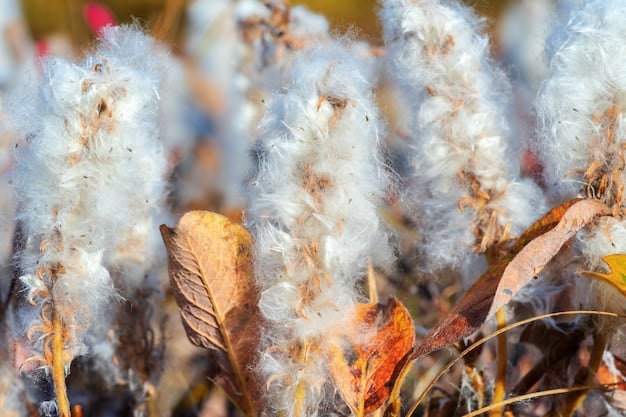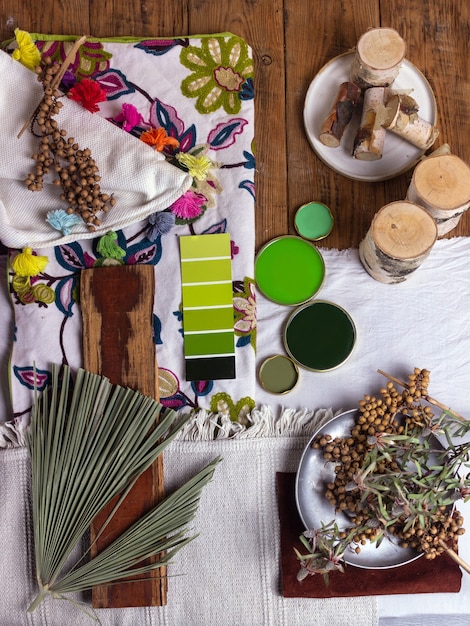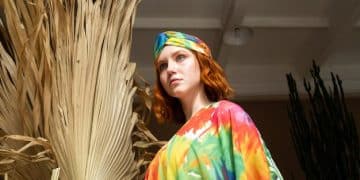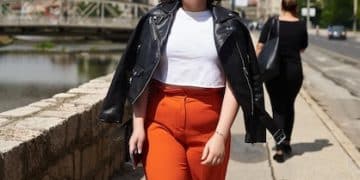Sustainable Fashion: 3 Eco-Friendly Fabrics for 2025

Sustainable fashion choices in 2025 will focus on eco-friendly fabrics like organic cotton, recycled polyester, and innovative plant-based materials, offering consumers stylish and environmentally responsible options.
Looking to make more sustainable fashion choices: 3 eco-friendly fabrics to look for when shopping in 2025? The fashion industry has a significant environmental impact, but you can help reduce it by choosing clothing made from sustainable materials. By 2025, several innovative and eco-conscious fabrics will be readily available and stylish, making it easier than ever to build a sustainable wardrobe.
Embracing Sustainable Fashion in 2025
As we move closer to 2025, sustainable fashion is becoming more than just a trend; it’s a necessity. Consumers are increasingly aware of the environmental and social costs associated with fast fashion, and they are actively seeking alternatives that align with their values. This shift in consumer behavior is driving innovation in the textile industry, leading to the development of new and improved eco-friendly fabrics.
Choosing sustainable fabrics is one of the most impactful ways to reduce your fashion footprint. These materials are produced using methods that minimize environmental damage, conserve resources, and promote ethical labor practices. By supporting brands that prioritize sustainable fabrics, you can contribute to a more responsible and circular fashion economy.
The Rise of Conscious Consumerism
Conscious consumerism is on the rise, with more people demanding transparency and accountability from the brands they support. This trend is fueling the demand for sustainable fashion and driving companies to adopt more eco-friendly practices. As a result, consumers in 2025 will have a wider range of sustainable options to choose from, making it easier than ever to build a wardrobe that is both stylish and ethical.
- Increased awareness of environmental issues.
- Demand for transparency in supply chains.
- Growing support for ethical labor practices.
Ultimately, embracing sustainable fashion in 2025 means making informed choices and supporting brands that are committed to creating a more responsible and circular fashion industry. By choosing eco-friendly fabrics, we can all contribute to a more sustainable future for fashion.
Organic Cotton: A Timeless Classic, Now More Sustainable
Organic cotton has long been recognized as a more sustainable alternative to conventional cotton. As we approach 2025, advancements in organic farming practices and increased consumer demand are making organic cotton an even more compelling choice for eco-conscious shoppers.
Organic cotton is grown without the use of synthetic pesticides, herbicides, or genetically modified organisms (GMOs). This reduces the environmental impact of cotton farming and protects the health of farmers and workers. However, it’s essential to look for certifications like GOTS (Global Organic Textile Standard) to ensure that the cotton is truly organic and meets stringent environmental and social criteria.

Benefits of Choosing Organic Cotton
Choosing organic cotton offers numerous benefits, both for the environment and for your health. Organic farming practices promote biodiversity, conserve water, and reduce soil erosion. Additionally, organic cotton is softer and more breathable than conventional cotton, making it a comfortable choice for clothing.
In 2025, expect to see a wider variety of organic cotton clothing and textiles available at more affordable prices. As demand for organic cotton continues to grow, production costs are likely to decrease, making it more accessible to consumers. Look for organic cotton in everything from t-shirts and jeans to bedding and towels.
- Reduced environmental impact compared to conventional cotton.
- Softer and more breathable fabric.
- Supports biodiversity and healthy ecosystems.
Organic cotton remains a reliable and sustainable fabric choice, with ongoing improvements in farming and processing techniques ensuring its continued relevance in the fashion industry.
Recycled Polyester: Giving Plastic a Second Life
Recycled polyester, also known as rPET, is a fabric made from recycled plastic bottles and other plastic waste. As we look to 2025, recycled polyester is poised to become an even more important component of sustainable fashion, offering a viable solution for reducing plastic waste and conserving resources.
The process of creating recycled polyester involves melting down plastic waste and spinning it into new fibers. This not only diverts plastic from landfills and oceans but also reduces the need for virgin polyester, which is made from petroleum. Recycled polyester has a lower carbon footprint than virgin polyester and requires less energy to produce.
Applications of Recycled Polyester in 2025
By 2025, recycled polyester will be used in a wide range of clothing and accessories, from athletic wear and swimwear to outerwear and bags. Advancements in recycling technology will continue to improve the quality and durability of recycled polyester, making it virtually indistinguishable from virgin polyester.
Consumers can also expect to see more brands incorporating recycled polyester into their products as part of their sustainability initiatives. Many companies are setting ambitious targets for using recycled materials, and recycled polyester is a key component of achieving these goals. When shopping, look for labels like “Made with Recycled Materials” or “rPET” to identify clothing made from recycled polyester.
- Reduces plastic waste in landfills and oceans.
- Lower carbon footprint compared to virgin polyester.
- Versatile fabric suitable for various applications.
Recycled polyester offers a practical and scalable solution for making fashion more sustainable. With ongoing improvements in recycling technology and increasing consumer demand, recycled polyester is set to play a significant role in the future of fashion.
Innovative Plant-Based Fabrics: The Future of Sustainable Textiles
Beyond organic cotton and recycled polyester, a new wave of innovative plant-based fabrics is emerging, offering exciting possibilities for sustainable fashion. As we approach 2025, these materials are gaining traction as designers and consumers seek alternatives to traditional textiles with high environmental impacts.
These fabrics are derived from renewable resources such as hemp, bamboo, seaweed, and even pineapple leaves. They are often processed using eco-friendly methods that minimize water and energy consumption, as well as the use of harmful chemicals. Some of these plant-based fabrics are also biodegradable, further reducing their environmental footprint.

Examples of Promising Plant-Based Fabrics
Several plant-based fabrics are showing great potential for sustainable fashion. Hemp is a fast-growing crop that requires little water and no pesticides. Bamboo is another renewable resource that produces a soft and breathable fabric. Piñatex, made from pineapple leaf fibers, is a vegan alternative to leather. Seaweed fabrics are also gaining attention for their eco-friendliness and unique properties.
In 2025, expect to see more designers experimenting with these innovative plant-based fabrics and incorporating them into their collections. Consumers can also support these materials by seeking out clothing and accessories made from hemp, bamboo, Piñatex, and other plant-based textiles. By embracing these new fabrics, we can drive innovation and create a more sustainable fashion industry.
- Derived from renewable resources.
- Often processed using eco-friendly methods.
- Offer unique properties and textures.
Plant-based fabrics represent the future of sustainable textiles, offering a diverse range of options for designers and consumers looking to reduce their environmental impact. With ongoing research and development, these materials are poised to transform the fashion industry and create a more sustainable future.
How to Identify Sustainable Fabrics When Shopping
Knowing what to look for when shopping can make all the difference in choosing sustainable clothing. As a conscious consumer in 2025, you’ll have several tools and resources at your disposal to help you identify eco-friendly fabrics and make informed purchasing decisions.
One of the most reliable ways to identify sustainable fabrics is to look for certifications from reputable organizations. Certifications like GOTS (Global Organic Textile Standard), Oeko-Tex, and Bluesign ensure that fabrics meet specific environmental and social criteria. These certifications verify that the fabric is produced using sustainable practices and is free from harmful chemicals.
Tips for Spotting Sustainable Fabrics
In addition to certifications, there are several other things to keep in mind when shopping for sustainable fabrics. Look for clothing made from natural fibers like organic cotton, hemp, and linen. Check the label to see if the fabric is made from recycled materials. Consider the manufacturing process and whether it is eco-friendly. By paying attention to these details, you can make more sustainable choices.
Furthermore, supporting brands that are transparent about their supply chains and sustainability practices is essential. Look for companies that provide information about where their fabrics are sourced and how they are produced. By supporting these brands, you can encourage more companies to adopt sustainable practices.
- Look for certifications like GOTS, Oeko-Tex, and Bluesign.
- Check the label for recycled materials and natural fibers.
- Support brands that are transparent about their sustainability practices.
Identifying sustainable fabrics requires some research and attention, but it is a worthwhile effort. By becoming a more informed consumer, you can help drive demand for sustainable fashion and contribute to a more responsible industry.
The Future of Sustainable Fashion Beyond Fabrics
While choosing sustainable fabrics is crucial, it’s essential to recognize that creating a truly sustainable fashion industry requires a holistic approach. As we look towards 2025, several other factors will play a significant role in shaping the future of fashion, including circularity, ethical production, and consumer behavior.
Circularity refers to designing products that can be reused, recycled, or composted at the end of their life. This reduces waste and conserves resources. Ethical production involves ensuring fair labor practices and safe working conditions for garment workers. Changing consumer behavior means buying less, choosing quality over quantity, and caring for clothing to extend its lifespan.
Beyond the Material: A Holistic View
Sustainability is not just about the fabric; it’s about the entire lifecycle of the garment. Brands are increasingly focusing on creating durable, timeless pieces that can be worn for years. Consumers are also embracing practices like clothing swaps, renting, and buying secondhand to reduce their environmental impact.
Technology is also playing a role in advancing sustainable fashion. Innovations like 3D printing and on-demand manufacturing are reducing waste and allowing for more personalized clothing. Blockchain technology is improving transparency in supply chains, making it easier to track the origin and production of garments.
- Promoting circularity through reuse, recycling, and composting.
- Ensuring ethical production and fair labor practices.
- Changing consumer behavior to reduce consumption and waste.
The future of sustainable fashion involves a combination of sustainable fabrics, circular practices, ethical production, and conscious consumerism. By embracing these principles, we can create a fashion industry that is both stylish and sustainable for generations to come.
| Key Point | Brief Description |
|---|---|
| 🌱 Organic Cotton | Grown without synthetic pesticides, promoting biodiversity and farmer health. |
| ♻️ Recycled Polyester (rPET) | Made from recycled plastic bottles, reducing waste and the need for virgin polyester. |
| 🌿 Plant-Based Fabrics | Innovative textiles from hemp, bamboo, and pineapple leaves, offering eco-friendly alternatives. |
| 🔍 Certifications | Look for GOTS, Oeko-Tex, and Bluesign to ensure sustainable and chemical-free fabrics. |
What are the key sustainable fabrics to look for in 2025?
▼
In 2025, prioritize organic cotton grown without harmful chemicals, recycled polyester made from plastic waste, and innovative plant-based fabrics like hemp and bamboo.
▼
Sustainable fashion reduces environmental impact, conserves resources, promotes ethical labor practices, and helps create a more responsible and circular fashion industry.
▼
Look for certifications like GOTS, Oeko-Tex, and Bluesign, check for recycled materials and natural fibers, and support brands with transparent sustainability practices.
▼
Organic cotton is softer, more breathable, and reduces environmental impact by eliminating synthetic pesticides and promoting biodiversity in farming practices.
▼
Recycled polyester reduces plastic waste by transforming it into new fibers, thus lowering carbon footprint compared to virgin polyester and conserving resources.
Conclusion
As we gear up for 2025, making sustainable fashion choices: 3 eco-friendly fabrics to look for when shopping in 2025—organic cotton, recycled polyester, and plant-based options—is more crucial than ever. By prioritizing these materials and supporting brands committed to ethical and transparent practices, we can collectively drive the fashion industry toward a more sustainable and responsible future.





